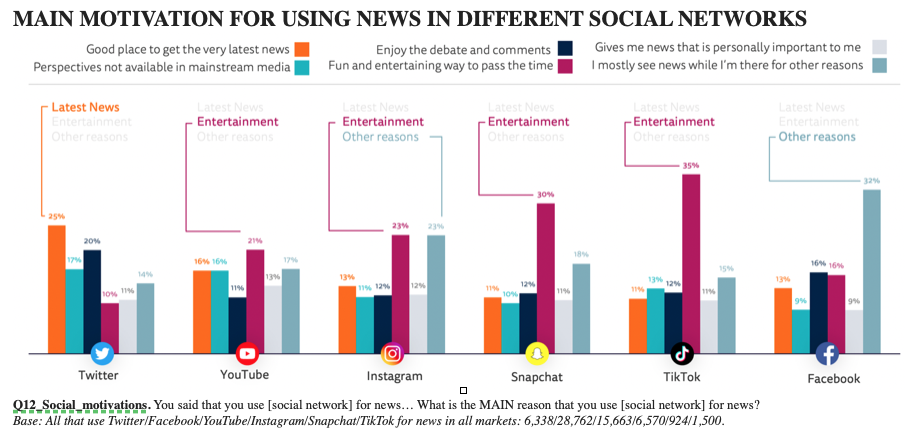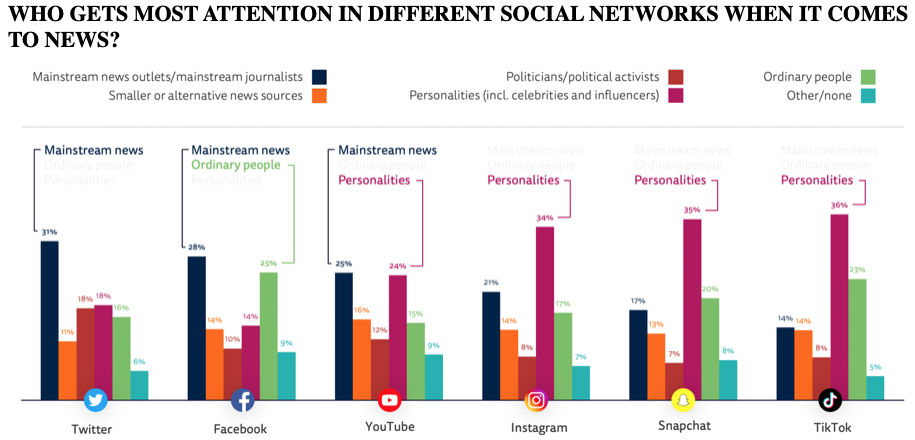
Instagram has long had a reputation as a place to escape the ‘real’ world, through carefully curated feeds of wholesome thoughts, videos and images. But over the past year Instagram, along with other youth focussed social platforms such as Snapchat and TikTok, has become full of heated debates around politics, race, and other issues of social justice - alongside updates about the coronavirus pandemic. Leading these debates are often not journalists but the celebrities, influencers and creators who dominate social online spaces – from lifestyle bloggers to reality TV personalities.
Over the last few years, our Digital News Report has documented the increased reliance of young people on social media when it comes to news. Four in ten (40 per cent) of those aged 18-24 say that social media is their main source of news, averaged across our 46 countries.
We have also documented how these groups are spending less time with networks like Facebook and more time with visual networks like Instagram, Snapchat and now TikTok. More than a quarter of 18-24s now say they access news on Instagram each week and around one in ten access news on TikTok, a network previously almost entirely devoid of political content.
None of this is to say that young people are necessarily going to these networks looking for news. Our data shows that when it comes to news, the main motivation is fun and entertainment. News is often incidental – in sharp contrast with Twitter, which is seen more as a destination for the latest news and commentary.

But this extraordinary year of news has been changing behaviour and expectations. Young respondents to our survey talked about how networks like Instagram have helped inform them or shape their opinions on stories as varied as coronavirus, climate change, the storming of the Capitol and the aftermath of the murder of George Floyd – from countries as varied as Nigeria, Sweden, Brazil and the United States.
In the wake of the Black Lives Matter movement, Instagram has become the platform for wide-ranging conversations about racism in the US. Many social media influencers have broken away from safe subjects like food, music and fashion talked about their own experiences of racial discrimination on the one hand or white privilege on the other.
Elsewhere, young activists across the world have embraced a range of networks including Instagram, TikTok and YouTube to organise protests against the ruling class. In Peru, anti-corruption protests were focused around the hashtag semetieronconlageneracionequivocada (they messed with the wrong generation). In Thailand, student-led pro-democracy protests fuelled by social media – including TikTok - have helped to open up a media that have long been reluctant to criticise the authorities. In many cases, the authorities seem to have been blindsided by platforms that they do not understand – with their distinct language of memes, emojis, and hashtags.
Ordinary people and influencers attract most attention when it comes to news
While journalists and media companies often lead conversation around news subjects when it comes to Twitter and Facebook, they struggle for attention in Instagram, Snapchat and TikTok. Here, it tends to be celebrities or other social influencers that attract most attention when it comes to news – as well as ordinary people. Politicians attract much less attention too, though we did find a significant number of respondents following posts by Alexandria Ocasio-Cortez (AOC) who has delivered viral content on both on Instagram and TikTok over the last year. The line between activist, politician and celebrity is perhaps hard to draw with Greta Thunberg also being widely mentioned as someone they listened to on climate change in different countries around the world.

Our research suggests that much of the news circulating on Instagram, Snapchat, and TikTok is related to subjects like health, fashion, and sexuality as opposed to more ‘traditional’ topics, such as politics or economics. Influencers often have strong opinions on these topics and frequently criticise the media for their perceived unfair treatment of women or LGBTQ individuals.
"The social media influencers and comedians that I follow are extremely opinionated, which is a good thing. Because of the number of people there [on social networks], you get better sources to hear both sides of the story," said a 19-year-old female Instagram user in India.
But these opinions can often get extremely heated. During the recent Israel-Palestine conflict, model Bella Hadid sparked a row over an Instagram post that suggested that Israel was not a country but rather a land settled by colonisers – leading to charges of anti-semitism and a social media tussle with the Israeli government.
Indeed, politicians are increasingly finding they need to take social media seriously. The Manchester United footballer Marcus Rashford used Instagram (15m followers) and Twitter to build support for an extension to free school meals for poor students during holidays. In the face of this onslaught, Prime Minister Boris Johnson (1.4m Instagram followers) was forced to back down after initially opposing the initiative.
On the other hand, many are concerned about the reliability and nature of the information young people may be getting from personalities in social media. Madonna and Lewis Hamilton were amongst celebrities accused of spreading conspiracy theories about coronavirus because of stories they had shared via Instagram or other networks.
Against this background, the World Health Organisation has created a CGI (computer-generated) 20-year-old influencer called Knox Frost to get "accurate, vetted information" about covid-19 to younger people. The Instagram account has been posting to around a million followers about coronavirus safety. Meanwhile the British government has enlisted and paid several social media influencers and reality TV stars to promote its national test and trace system and claim to have reached more than 7 million people in its target group.
The role of journalists?
Could journalists and news organisations play a more prominent role on these networks and provide more credible information? Or are these spaces ill-suited to providing background and context on complex and nuanced stories like the Israel-Palestine crisis?
Social media are certainly a complex space to navigate and many publishers have been wary about getting stuck in. But others think it is important to engage in networks where young people are spending much of their time – and to find ways of adapting the tone and format of the news for these more informal spaces.
Traditional publishers like the Economist and Le Monde have had some success with short for visual content on Instagram and Snapchat respectively while the Washington Post has used TikTok, amongst other things, to encourage young people to vote. The BBC’s Sophia Smith Galer has pioneered experimental storytelling on TikTok, such as creating a viral sea shanty about the blocking of the Suez Canal by a container ship, and the German public broadcaster ARD has built a quirky TikTok presence for its daily news show Tagesschau.
Newer youth-orientated networks represent a significant challenge for mainstream media. News is largely incidental and the expectations of snappy, visual, and entertaining content do not always come naturally to newsrooms staffed by older journalists with a focus on traditional formats. But with serious news now being widely discussed in networks like Instagram and TikTok, the engagement of journalists could help to bring more reliable content and new perspectives to these discussions
Nic Newman is the lead author and Simge Andı is co-author of the Reuters Institute Digital News Report which can be accessed here
Want to receive journalism news and job updates straight to your phone? Subscribe to Journalism.co.uk on our Telegram jobs channel for the latest job opportunities, and our news channel for a weekly digest every Monday morning.
Free daily newsletter
If you like our news and feature articles, you can sign up to receive our free daily (Mon-Fri) email newsletter (mobile friendly).
Related articles
- What will your audience want in the future?
- Building trust during 2024 elections with live-blogging and fact-checking
- New blockchain verification tool to help fight the use of deep fakes in elections
- Trust is not a "useless metric" - we just need to understand it better
- News for All explores how journalism can fix its trust issues









